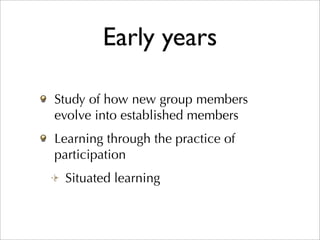Gic2011 aula8-ingles
- 1. Information & Knowledge Management Class 8 - Communities of Practices Marielba Zacarias Prof. Auxiliar DEEI FCT I, Gab 2.69, Ext. 7749 mzacaria@ualg.pt http://w3.ualg.pt/~mzacaria
- 2. Sumário Communities of Definition Origins and development Benefits Success factors Actions to cultivate communities of practice Tool section Innovation Cast Online communities
- 3. Definition Group of people sharing an interest, profession, hobby, skill, art or craft. Emergent or designed Driving principle: People develop personally and professionally through sharing information and experiences
- 4. Starting point “Situated learning: legitimate peripheral participation” Lave & Wegner 1991 Focus of: Learning theory Knowledge management
- 5. Early years Study of how new group members evolve into established members Learning through the practice of participation Situated learning
- 6. After that... CoP structured by: “Mutual Engagement” Establishment of norms and construction of collaborative relations through participation “Joint Enterprise” Shared understanding of “Mutual Engament” “Shared Repertoire” Shared vocabulary and meanings
- 7. Presently Learning through social participation The individual as an active participant in community practices and in the construction of his identity within the group Community of Practice is a group of individuals that participate in an activity
- 8. Structure Domain Shared knowledge area Community Strong social “Tissue” fosters interaction and encourages the will of sharing ideas Practice Specific focus on practice
- 9. CoP in organizations Integral part of some organizational structures Allows “knowledge stewarding” Knowledge sharing to improve productivity Allow capturing tacit knowledge
- 10. CoP Roles Reduce the learning curve of new participants Answer more quickly to customer needs Reduce re-work and avoid re-inventing the wheel Generate new ideas about products and services
- 11. Features Organically created with as many goals as individuals Membership defined by knowledge and expertise Indefinite duration Active participants Sharing of rules of thumbs and good practices, help and support among members
- 12. Benefits Social Capital Multi-dimensional concept Privada & public facet Value for the individual and the group Acquired through interactions of information, formal sharing processes, and learning from others
- 13. Success factors Individuals in the community Social Presence Motivation Collaboration
- 14. Individuals in the community Members are effective condutors of information e experiencies Complement organizational manuals Fosters “storytelling” between colleagues that improves professional skills
- 15. Individuals at the community Study shows that workers invest 1/3 of their time searching for information 5 times more probable ask colleagues thant search for explicit knowledge sources manuals, data bases or books Integrating them in a CoP allows saving time
- 16. Individuals in the community Member have tacit knowledge difficult to express or store A person may tell another how to deal with a situation, shortening his/her learning curve Sharing through discussions and brainstorming
- 17. CoP as a bridge.. Between theory and pratice Theory = know things (know-what) Pratice = know how to apply theory (know-how) CoP help individuals in linking theory with pratice
- 18. Social Presence Communicate with each other entails creating social presence Degree of salience of another person in an interaction and the consequence salience of the interpersonal relationship Determines the participation in a communitiy
- 19. Barriers that hinder individual participation (in knowledge sharing) in a CoP egos personal attacts big intimidatory communities time restrictions
- 20. Motivation Individuals are motivated to share when knowledge is regarded as: public asset a moral obligation a community interest tangible incentives (raises, bonuses) or intangible incentives (auto-esteem, respect)
- 21. Collaboration Sveiby and Simons (2001) Collaborative environment essential for “knowledge work” to be effective Experience, age, power e education Enterprise dimension and distance
- 22. Actions to build CoP Design the community to evolve organically Create the opportunity of open dialogues and external perspectives Allow several participation levels leaders (centre) regular participants less active participants (periphery)
- 23. Actions to build CoP Create public and private spaces Focus the community value Combine novelty with familiarity Find and follow the rhythm of the community
- 24. Practice Networks (RoP) Variant of CoP Informal social network that emerges from information sharing among people with common practice areas Entails looser relations Electronic networks blogs, foruns, mailing lists
- 25. CoP Online CoP virtual supported by IT May extend traditional communities First CVs in the 90’s TheGlobe, Geocities, Tripod Social web appears from year 2000 Flicker, Twitter, FB, Delicious, etc.
- 26. Types of online CoPs Genres: Mommy blog, Political blog Member life cycle Theories about characters Example: use of avatars & v characters
- 27. Member life-cycle 1. Peripheral (only reads - lurker) 2. Newly arrived that participates and it is decided to form part of the community (inbound) 3. Regular Participant (committed) 4. Leader: supports the participation of others and performs intermediation tasks 5. About to leave (outbound)
- 28. Example: YouTube 1. We only see videos 2. We occasionally put some videos and comment others 3. We put videos regularly. We comment and evaluate videos from others 4. We abandon the community due to lack of interest or time
- 29. Difussion Model
- 30. Online Participation Anticipated reprocity Greater acknowledgement Online identity Sense of efficacy Sense of community
- 31. The FB case Personality influences the way of using FB Extroverted as a complement Introverted as a substitute High in neuroticism like the Wall Low in neuroticism like pictures Open to new experiences use as a different way of socializing Competency and familiarity time in FB and wall visit frequency
- 32. Tool Section
- 33. Innovation Cast
- 34. Managing the Innovation Process Challenges and marketing campaigns Idea Management Innovation opportunities Innovation Projects Prize and acknowledgment management Innovation analytics Collaboration tools
- 35. Idea Management
- 36. Collaboration
- 37. Idea Management
- 38. Analytics






































